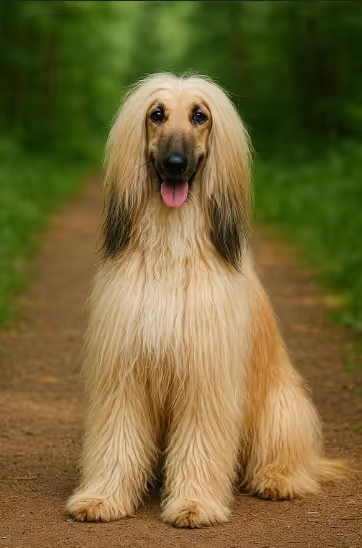The Afghan Hound is a striking and noble breed, famous for its flowing coat, regal appearance, and aloof demeanor. Originally bred for hunting large game in the rugged mountains of Afghanistan, this breed combines elegance with athleticism. Afghan Hounds are known for their independence, sensitivity, and unique personality. They thrive in calm, structured environments and make loyal companions for experienced dog owners who appreciate their quiet sophistication.

The Afghan Hound is one of the oldest known dog breeds, with lineage dating back thousands of years to the Middle East and Central Asia. Revered by royalty and nomads alike, these dogs were used by Afghan tribes for hunting gazelle, deer, and even leopards across harsh terrains. They were prized not only for their speed and agility but also for their bravery. The breed was introduced to the Western world in the 19th century and quickly gained attention in show rings for its beauty and exotic appeal. Today, the Afghan Hound is celebrated both for its historical roots and its striking presence.
The Afghan Hound is tall, lean, and graceful, with a long, silky coat that flows as it runs. It has a narrow head, prominent hip bones, and a proud posture. Its long tail curves into a ring at the end. Coat colors vary widely and include cream, black, blue, red, and silver. Their dark, almond-shaped eyes give them a thoughtful, almost mysterious expression. The breed’s elegant movement and distinct gait make it stand out in any setting.
Afghan Hounds require intensive grooming. Their long, fine coat must be brushed thoroughly 2–3 times a week using a pin brush and metal comb to prevent matting. Regular baths (every 2–3 weeks) are essential, along with careful drying to preserve the coat’s texture. Special attention should be paid to the ears and feet. This breed is not ideal for owners looking for low-maintenance grooming. Professional grooming services may be necessary for those unfamiliar with coat care at this level.
Although elegant and laid-back indoors, Afghan Hounds have bursts of high energy and require daily exercise. A securely fenced yard is ideal, as their prey drive makes them prone to chase. Off-leash play in a safe area or long leashed walks combined with agility or lure coursing are great options. Without proper physical and mental stimulation, they can become bored or anxious.
Afghan Hounds are intelligent but extremely independent, which can make training a challenge. They respond best to calm, consistent training using positive reinforcement techniques. Early socialization is key, especially with other dogs and people. Avoid harsh corrections — they are sensitive and may shut down. Patience and creativity go a long way when working with this breed.
Afghan Hounds do well on high-quality kibble or a balanced raw diet tailored to large, lean breeds. Foods with moderate protein and healthy fats support coat health and energy. Due to their deep chest, they can be prone to bloat — feeding them smaller meals twice a day and avoiding exercise immediately after meals is recommended. Omega-3 supplements can help keep their coat glossy.
Afghan Hounds are generally healthy, but like all breeds, they have predispositions. Common concerns include:
When adopting an Afghan Hound, look for breeders who conduct health testing and follow ethical practices. Ask about:
Are Afghan Hounds good with kids?
Afghan Hounds are typically reserved and prefer a quiet environment. They may not tolerate rough play from small children, but they can be calm companions for older kids.
Do Afghan Hounds shed a lot?
They are low shedders, but their long coat requires significant upkeep to prevent mats and tangles.
Can Afghan Hounds be left alone?
They are independent but can develop separation anxiety if left for extended periods regularly. Crate training and gradual absences can help.
Are Afghan Hounds hypoallergenic?
No. While they shed minimally, they are not considered hypoallergenic due to dander.
What are some good activities for Afghan Hounds?
They excel in lure coursing, scent tracking, and agility when properly motivated.